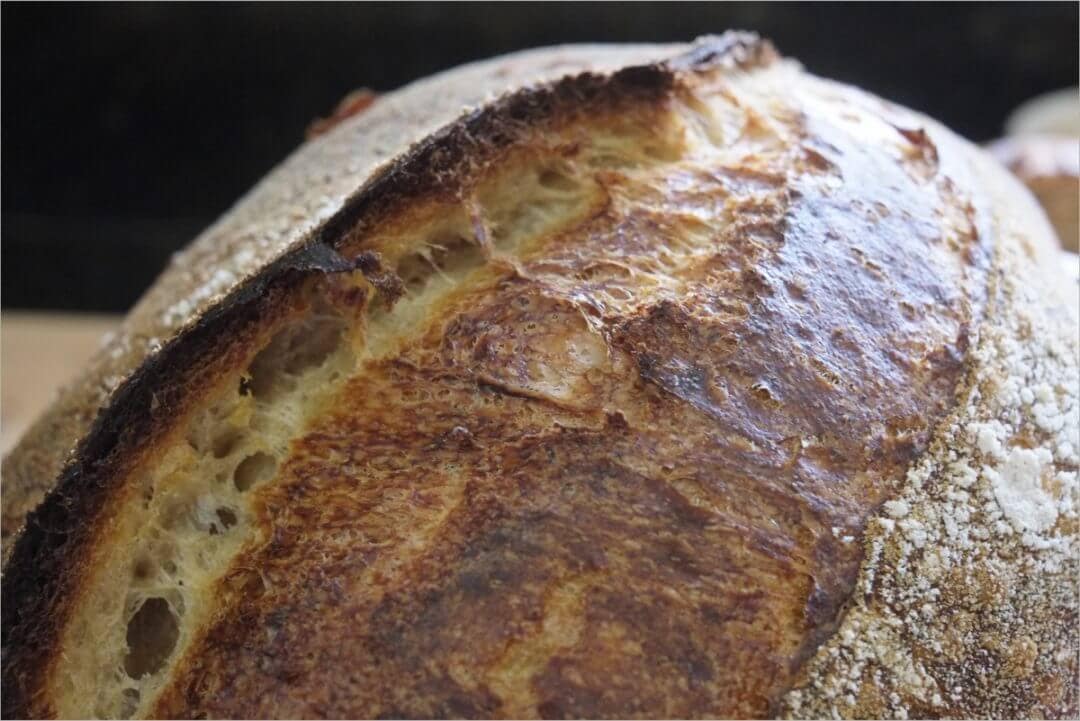My wife keeps telling me: “every time you bake you keep saying ‘Wow this is the best bread I have ever made’ the saying is getting old now… Hmmm, this is delicious bread though, I think it is your best so far.” I’ve had some recent bakes that have just been a step or two above my usual. I find it hard to stop eating slice after slice with anything I can moderately justify placing on top (I even scraped up some onions and currants from a recent meal we had and used it in a sandwich—yikes that was good.). It’s dangerous when your bread just comes out great; you become a somewhat selfish person and hoard all the slices for yourself. And in this post, my sourdough bread with a young levain ranks pretty high up there.
This post has me continuing my streak of experiments with high hydration sourdough bread using a “young” levain (as I mentioned in the last entry). Chad, in Tartine Bread, makes it a point to say he usually uses a young levain and prefers this to a more ripe version. It’s an interesting approach, something I’ve enjoyed exploring.
As an aside, I keep the acid load in my starter to a minimum by either feeding it once a day with a hefty amount of flour (~100g) or multiple feedings per day. Doing either of these will discard most of the acidity produced by your starter, which in the end will push the resulting loaf away from a sour one. This subtle sourness is my preference. So, how can you tell if your starter is fermenting too fast by the time you feed it again? Just give it a smell right before you do your regular feeding. Does it smell sourish and vinegary? Is it very soupy and runny? It probably needs to be fed with more flour or an earlier feeding. See my previous post on starter management for more information on these topics.
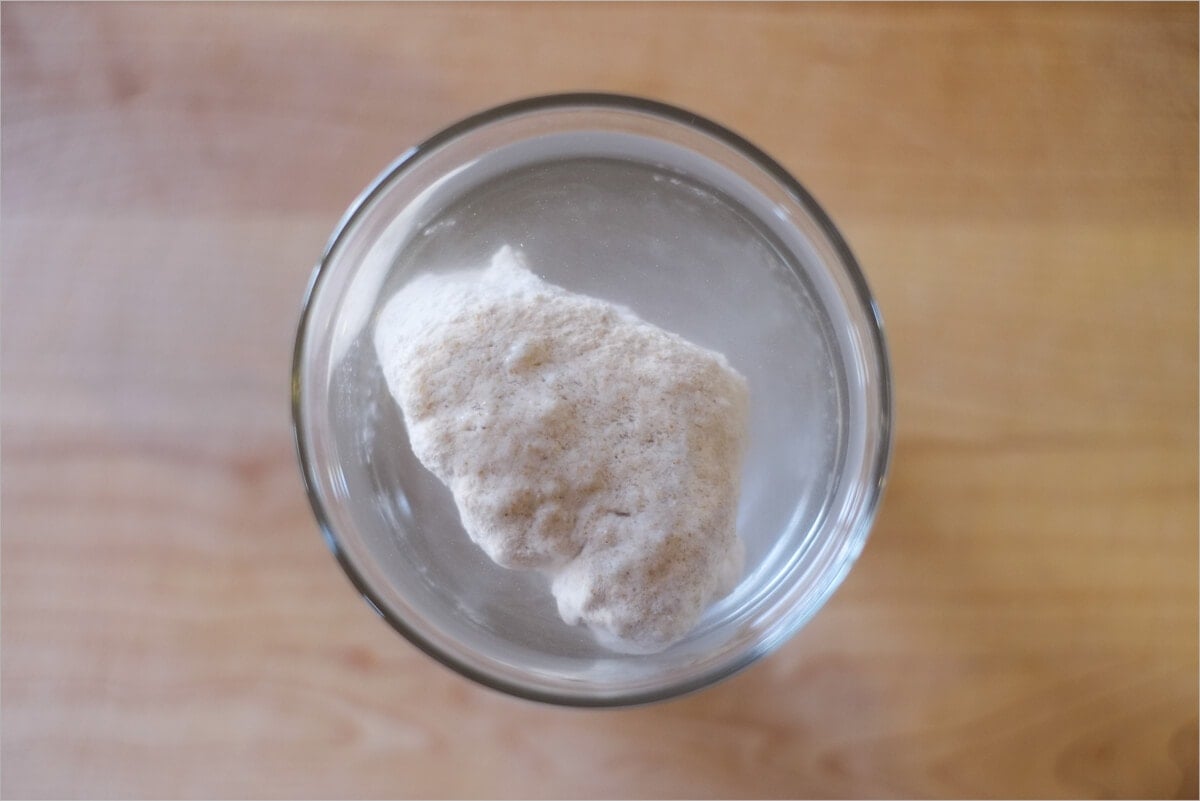
How young can this young levain be and still rise your bread properly? This entry has me using my levain at the earliest ever, just 3 hours after mixing in the early morning. I was very, very skeptical it was going to have enough strength to leaven my dough, but I did a quick float test (which isn’t a definitive test, but still a good general indicator) and sure enough, it floated happily at the top of my glass. I decided to go ahead and proceed knowing if it didn’t work out at least I’d have an excellent story to writeup here.
As you well know, I’ve been making only whole wheat bread for a little while now and have become accustomed to wrangling that dough into a loaf that has some loft to it. Well, the bulk step on this dough sure was a breeze. As it was progressing I could see the strength develop quite quickly, but in the beginning, the dough was very slack, I probably pushed the hydration a little too far. Next attempt with this flour will be done with slightly lower hydration, say 3-5%.
Sourdough Bread with a Young Levain
Prepare the levain – 6:45 a.m.
The following levain build was kept at around 77°F (24°C) ambient temperature and started in the morning on the day I mixed the dough, rather than the night before.
- 25g ripe starter
- 50g Bob’s Red Mill whole wheat flour
- 50g Sangre de Cristo white flour (King Arthur all-purpose flour would also work well)
- 100g water
After mixing the above in a thick-walled glass container, cover and set in a slightly warm area, around 77°F (24°C), for about 3 hours. The warm water helped move the fermentation along to get this levain ready in short order. I usually do a build that lasts around 10-12 hours overnight starting with room temperature water. As I mentioned above, it readily passed the float test, and so I proceeded.
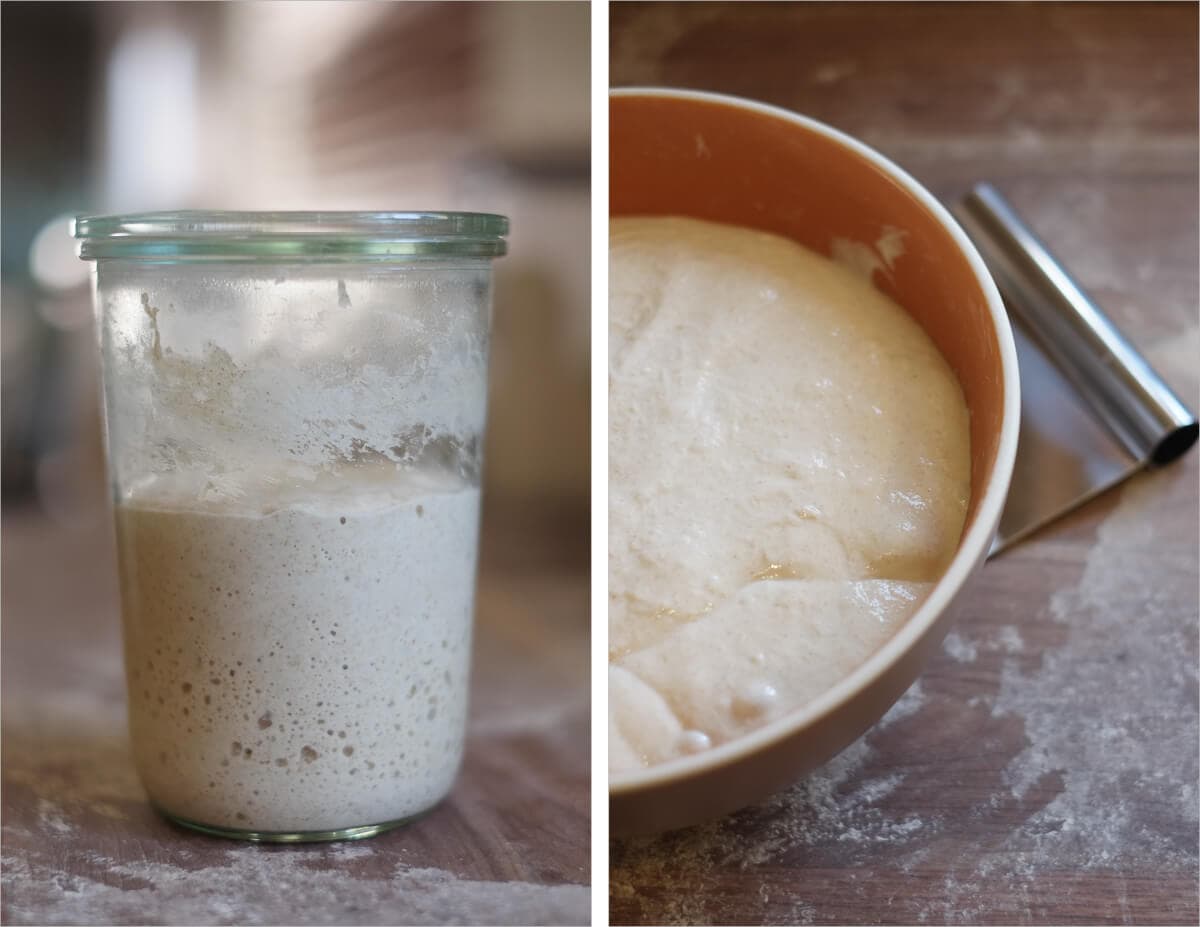
I should also mention that at this point my starter is a rather vigorous animal. I created my starter using my post on creating a sourdough starter from scratch a while ago, I refresh my starter twice per day, and it has gone without refrigeration for some time. When maintained properly a starter can get rather active, which is a great thing because this strong fermentation activity will transfer to the dough given the right conditions.
Keep an eye on your levain and employ the float test from time to time if you are unsure, each starter is different, and thus you must adjust your timetable to suit! Let’s start the autolyse.
Autolyse & Mix – 9:45 a.m.
Gather the following ingredients:
| Weight | Ingredient | Baker’s Percentage |
|---|---|---|
| 900g | All-purpose white flour (Sangre de Cristo) | 90% |
| 100g | Whole wheat flour (King Arthur whole wheat flour) | 10% |
| 20g | Salt | 2% |
| 900g | Water | 90% |
| 225g | Ripe levain | 22.5% |
Method:
One Hour Autolyse:
- In a thick bowl add in your 225g levain
- Add 850g water to your mixing bowl and mix with your hand until the levain is wholly dissolved
- Add in your white and whole wheat flours
- Mix by hand until all the dry flour is incorporated
- Cover with plastic wrap and keep covered in a warmish place in your kitchen at around 77°F (24°C) for 1 hour
While your dough is in autolyse thing, head outside for a bit while it’s still cool. I took my German shepherd, the “beast,” for a quick hike through the mesa near our house. I enjoy hiking around as she runs around me investigating every single bush, lizard, mysterious hole, and the occasional rabbit. Signs of Spring are emerging, and the foliage in my area is flush with flours and the trees are all turning green. This month is one of my favorite times of the year as it signals the time for me to emerge, get some more sun, and do some exercise outside.

Ok, back from your activities outside? Let’s get on with this, time to mix things up. After a full one hour autolyse:
Add to your autolysed dough:
- 20g sea salt
- Remaining 50g warm water
Cut the salt into the dough by mixing with your hands. Keep mixing relatively gently until the salt is mixed through and the dough turns a bit sticky.
| Final dough temperature: | 78°F (25°C) |
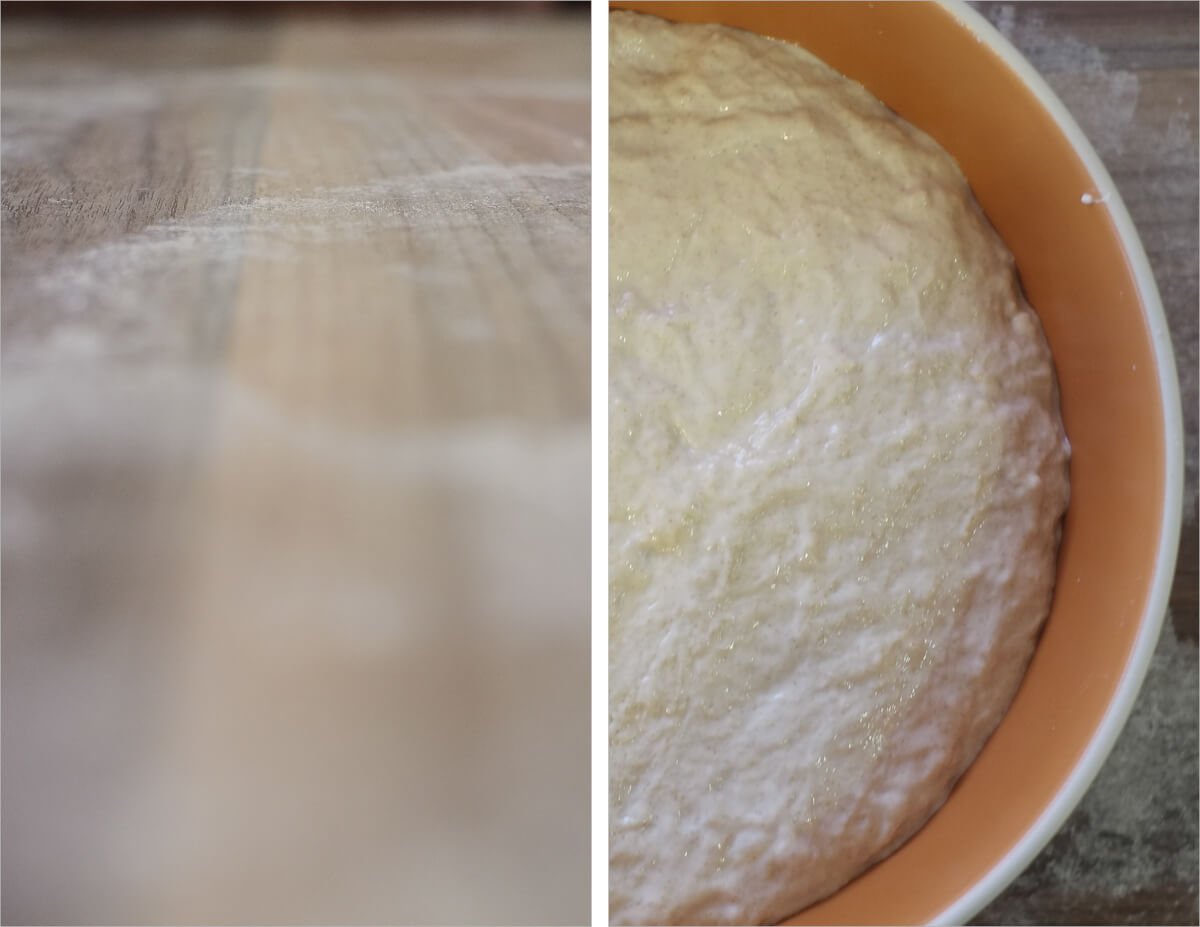
Bulk Fermentation – 10:45 a.m.
You’ll notice after the autolyse and mix the dough has some pretty good strength to it, yet it is extensible enough to stretch out without snapping back.
- 11:30 a.m. – Turn Set 1
- 12:00 a.m. – Turn Set 2
- 12:30 p.m. – Turn Set 3
- 1:00 p.m. – Turn Set 4
- 1:30 p.m. – Turn Set 5
- 2:00 p.m. – Turn Set 6
- 2:30 p.m. – Turn Set 7 (Easy set of turns)
- 3:00 p.m. – 4:00 p.m. – Rest on counter untouched
Note that a “Turn Set” here is 4 stretch and folds. I reach under my dough, pull up, and fold over the other side that’s done four times.
I had to up the number of turn sets during this bulk fermentation as the dough was pretty slack. The extended autolyse relaxes the gluten a little more than my usual 40 minutes, and the very high hydration also promotes a very extensible dough. After doing my folds at step #4, I could see I had to keep with the turns as the dough didn’t hold it’s shape well enough. An excellent visual indicator is by the time you’re done doing your four folds for that set, take notice of how the dough is resting in your bowl. If it isn’t holding its shape very well, meaning it kind of spreads out quickly after that last turn, you should probably do another set in 30 minutes.
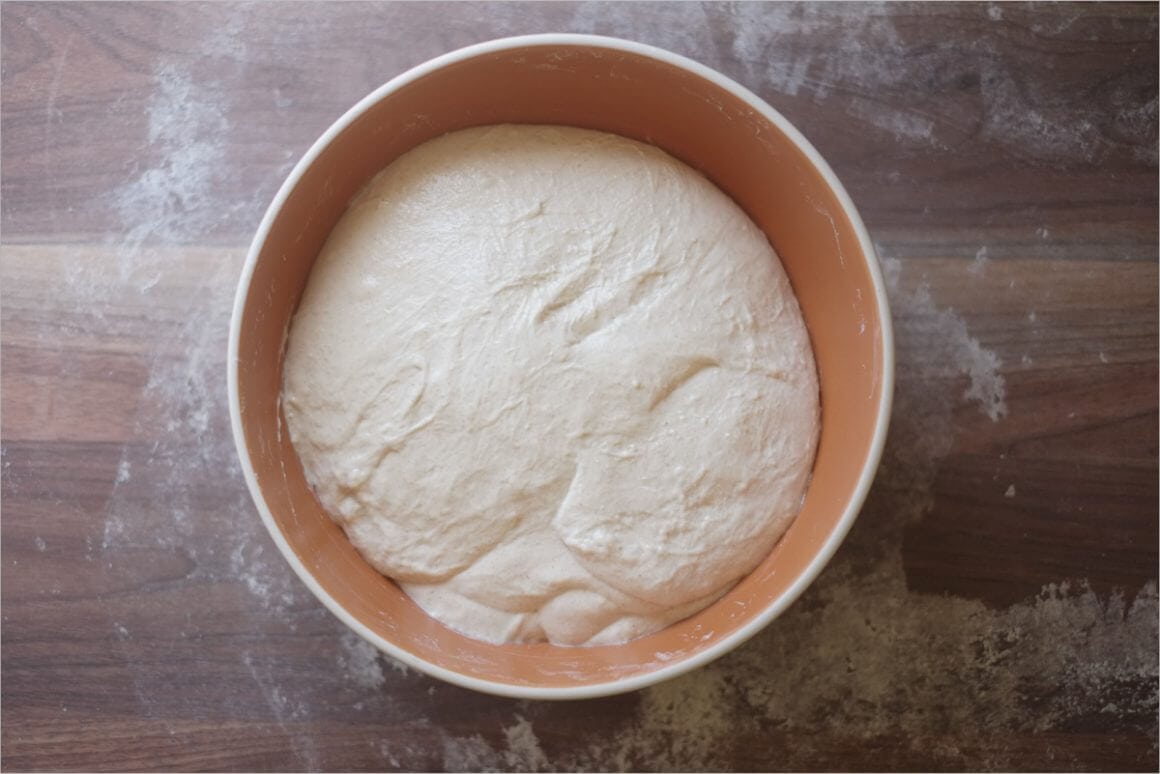
Pre-shape – 4:00 p.m.
Take the dough out of the container onto your work surface and sprinkle some flour on top before dividing. Divide the mass into two halves and lightly spin each half with your dough knife in one hand and your other hand. Let this pre-shape rest, covered with a damp towel or inverted bowls, for 20 minutes.
Lightly dust your proofing baskets with white or brown rice flour in preparation for the next step.
Shape + Proof – 4:20 p.m.
I’m going to warn you here, this 90% hydration dough is very tricky to shape. Only keep your hands in contact with the dough when necessary and always keep them lightly floured. Even doing all this you might have trouble lifting the dough off your surface, and you’ll surely have dough sticking to your bench knife and hands. It’s ok though, that’s part of the fun, and things will improve with practice.
Given the fact that my dough was so extensible, I decided to shape both of them as a batard. I was able to get quite a tight skin on the outside of these loaves, but they needed some support in their proofing baskets.
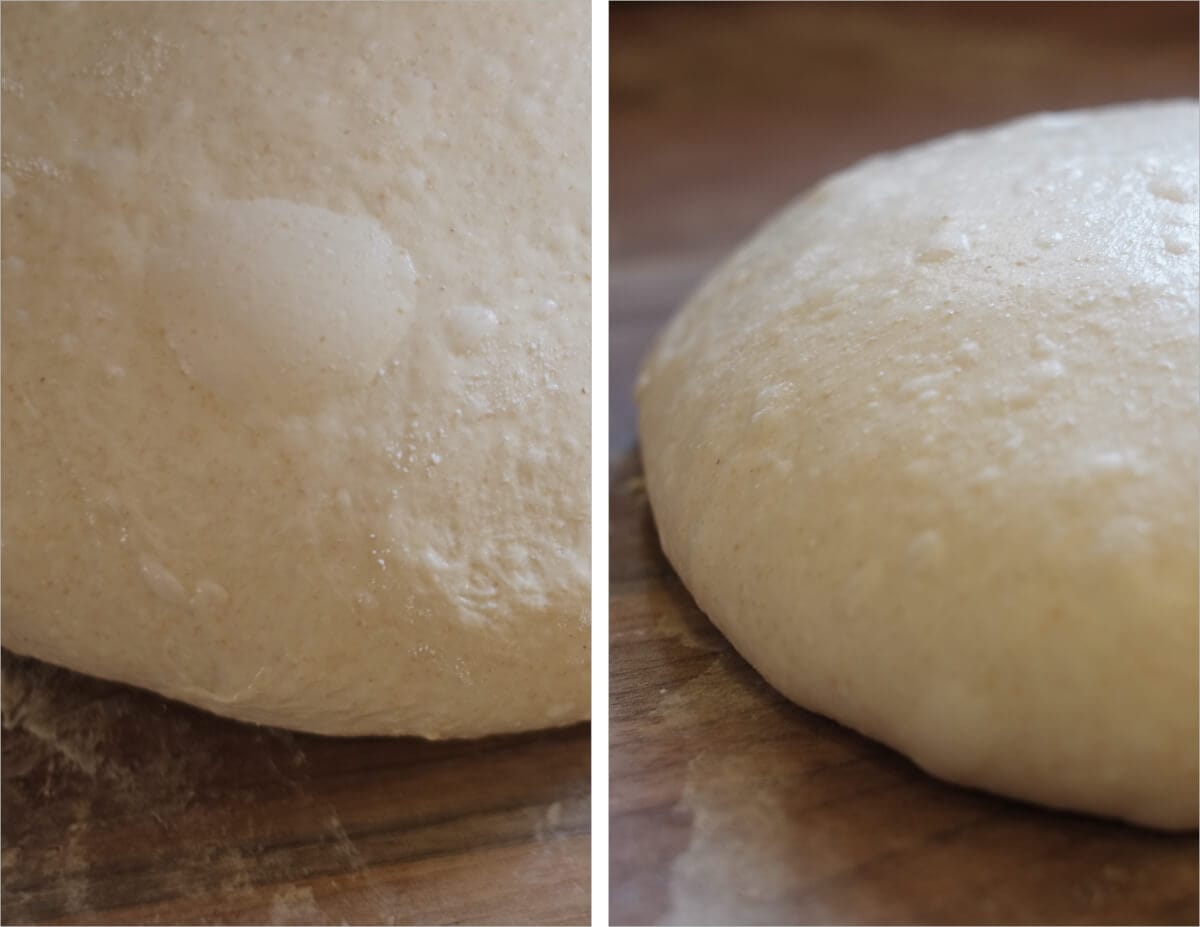
When hydration gets very high like this, I’ve started providing a little extra support to my proofing dough with linen in my bannetons. I place a flour sack towel on the bottom of the basket tied around at the rim with a rubber band. This holds the towel a bit off the bottom of the basket to keep the dough from expanding out too far filling the entire base.
After shaping both loaves, place them into their proofing baskets and cover each tightly. Please them immediately into the fridge for their overnight, cold proof.
Score + Bake – 7:15 a.m.
The morning I was to bake these two loaves was a very busy one. We are selling our home and moving to a new place across town and had a realtor showing in the early afternoon. Knowing I’d have to clean things up after the bake and that they would also see a loaf of freshly baked bread on the counter, I decided to go ahead and bake (I mean really, wouldn’t the house smell so amazing anyone viewing the house would just want to buy it immediately?). I guess my real fear was that these visitors would walk off with my hard work and enjoy my bread in the car on their ride to the next house… Remember my comments above about selfishness?
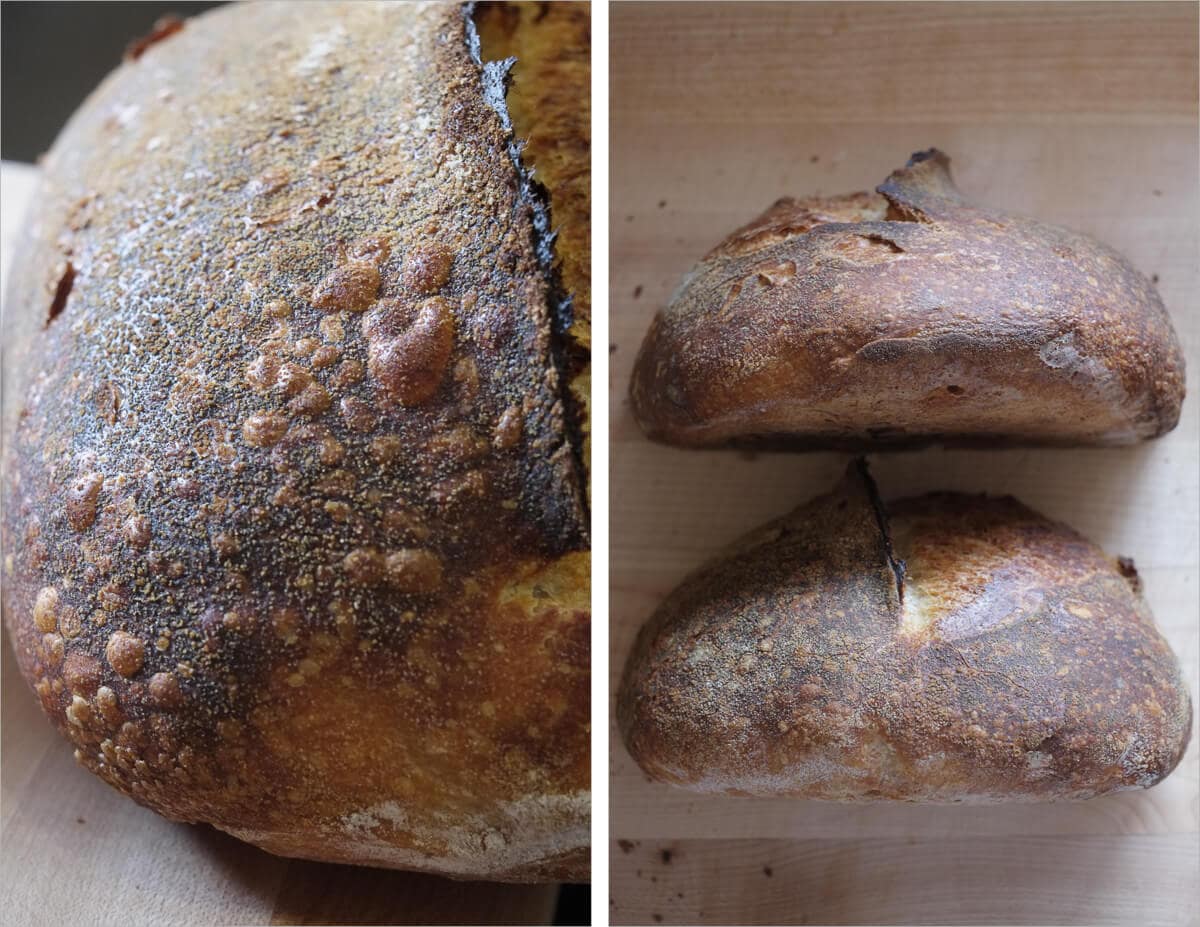
Preheat your oven to 450°F (230°C). I baked these loaves following my guide to baking in a Dutch oven (or combo cooker).
Because of the
Carefully take out the shallow side of your Dutch oven from the preheated oven and drag in your dough resting on parchment. Quickly place the pot back in the oven, cover with the deep end of the Dutch oven, and bake for 30 minutes.
After 30 minutes, open the oven and take off the lid of the combo cooker (set it next to the other half inside the oven), and bake for an additional 25-30 minutes until well colored.
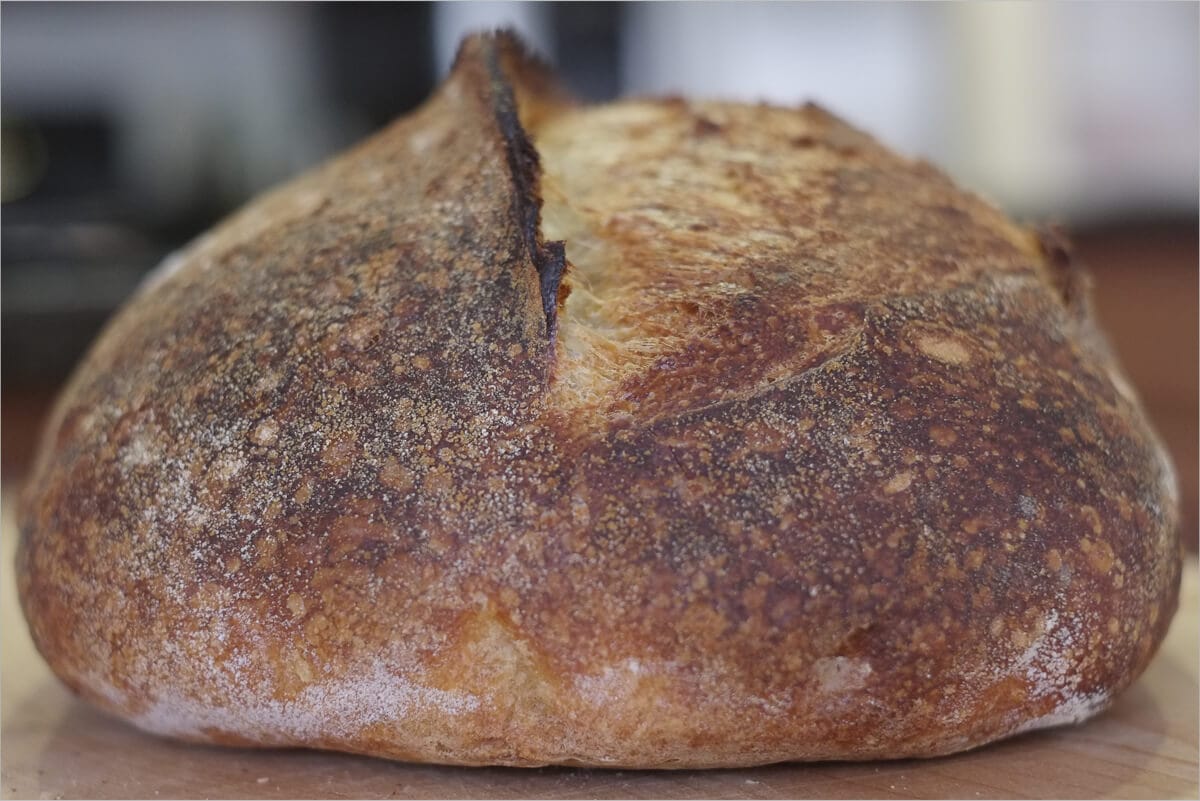
Conclusion
As my wife confirmed, this is the best set of white country sourdough loaves I’ve made. No doubt about it. I brought one loaf to our family Easter lunch, and it was gone in record time. Everyone commented on how soft and tender the crumb was, and how the sour flavor was so subtle, it only shows its head barely at the end. The young levain does impart a remarkable, complex taste without overpowering things.
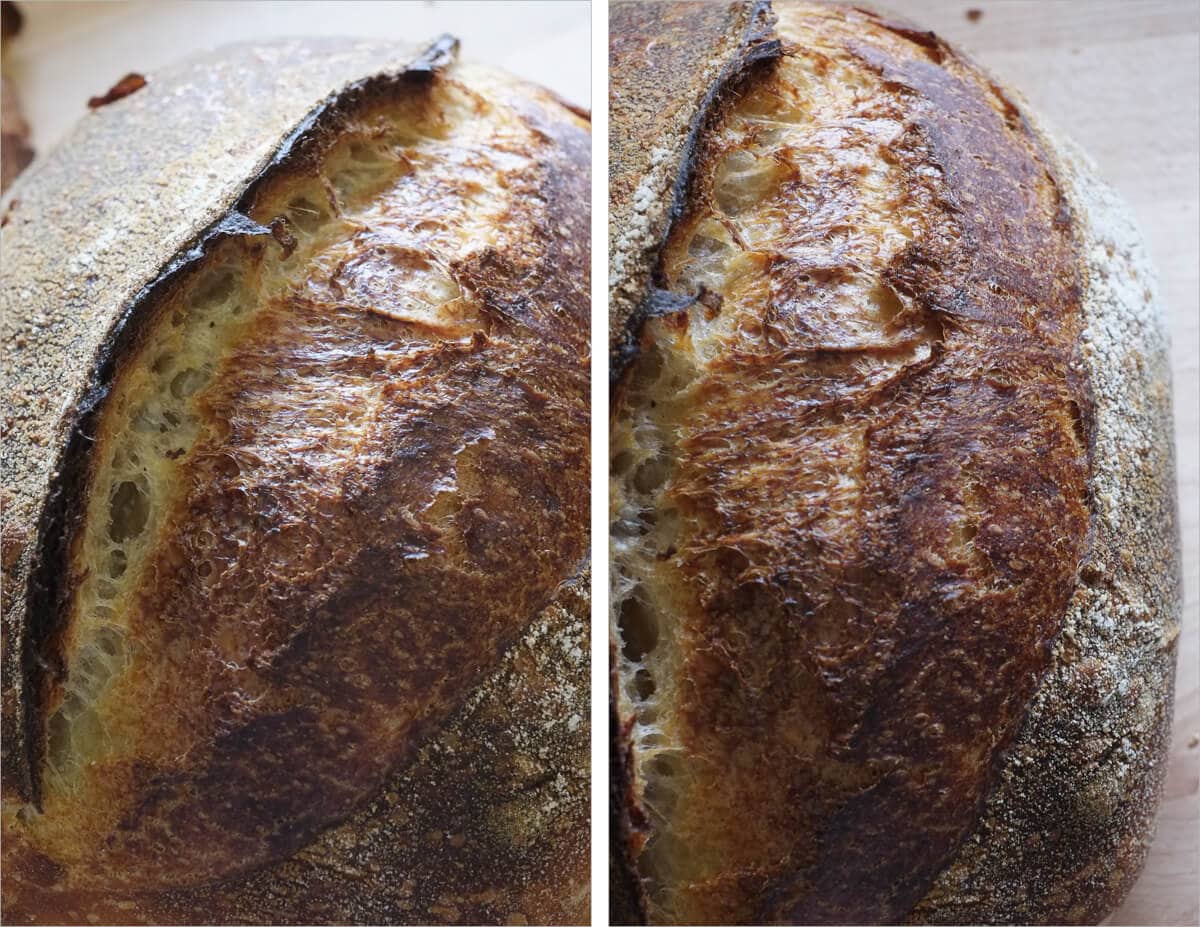
Crust
The crust was incredibly brittle, it was almost thin like a tortilla chip. Incredible. Even after the loaf sat out for a half of a week, it was soft, and easy to cut through and that’s saying a lot here in New Mexico where things dry out to cracker-like consistency in a matter of hours. Look at the range of colors in that crust!
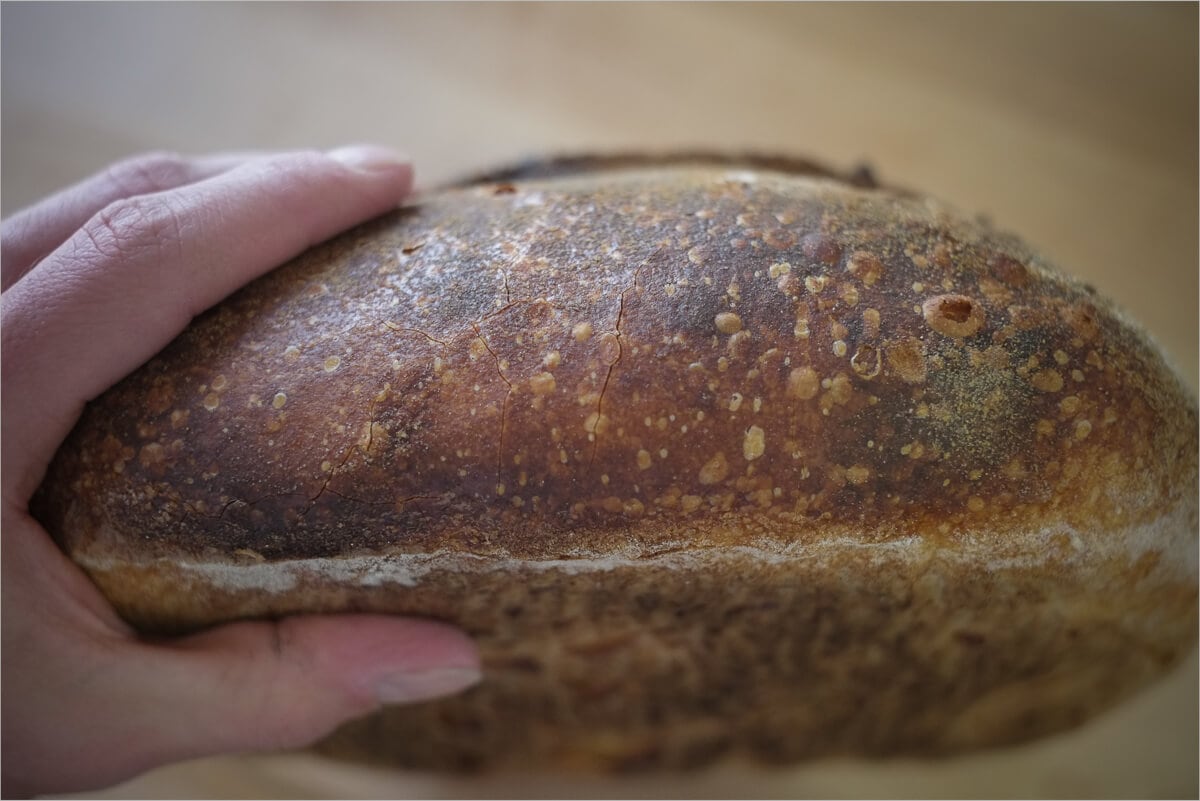
Crumb
The crumb on these loaves was superbly soft and tender. 90% hydration makes the inside of these loaves almost resemble a custard; it’s that moist in there. Pulling pieces apart with your hands has the crumb springing after it snaps irregularly, a most satisfying sight, one that reminds me of my Italian family breaking large pieces of bread at the dinner table.
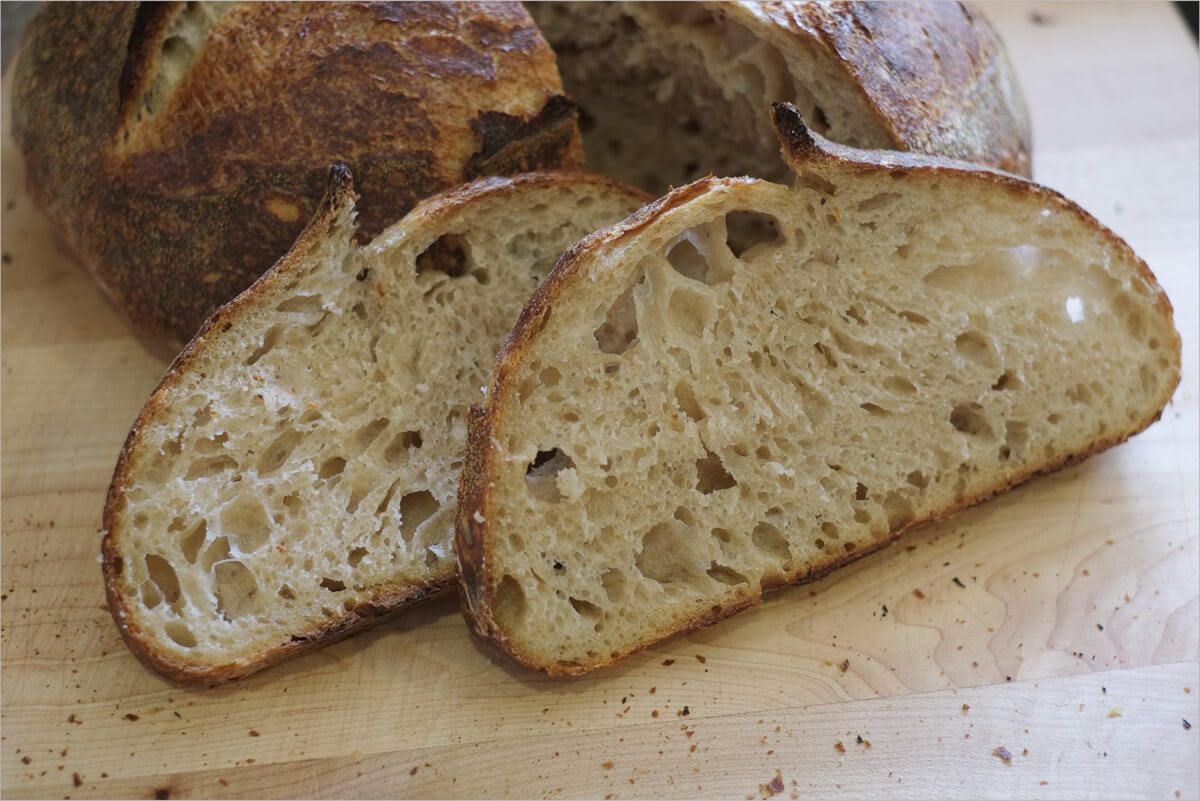
Taste
Toast this bread and tell me you can only eat a single piece. Go ahead, write back and let me know if that’s possible. I usually eat a single big slice at a time, but with these loaves, I was cutting two. If I can bake bread like this consistently, I’m going to be a very, very happy man. As will my friends and family.
I mentioned earlier that I used a few slices of this bread to make an insanely good sandwich, this is a sandwich I would serve at a restaurant, and I know it’d be a hit. We cooked a recipe recently using caramelized onions, currants, and a paste made from harissa and water. I spread this concoction on one side of the bread, topped it with grilled chicken, tomato, lettuce, and some creamy cheese. Gone in an instant!
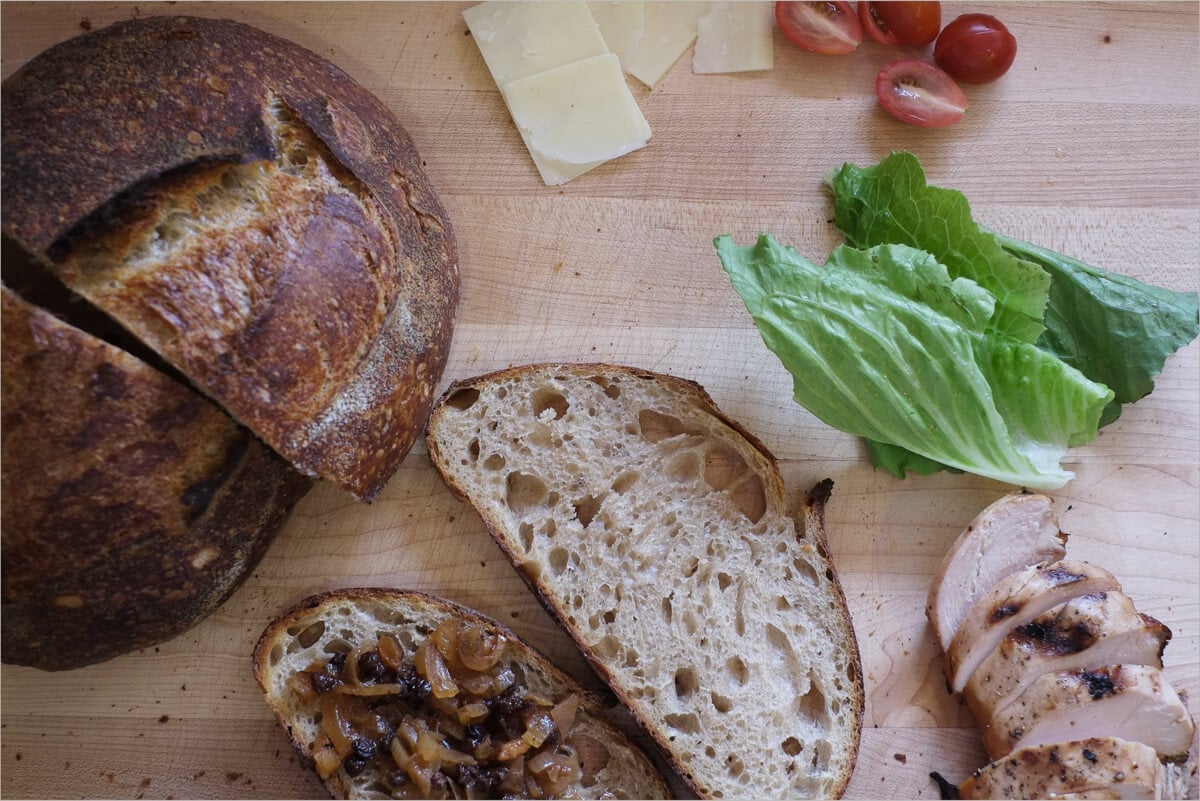
Buon appetito!
If you use this recipe, tag @maurizio on Instagram so I can take a look!


